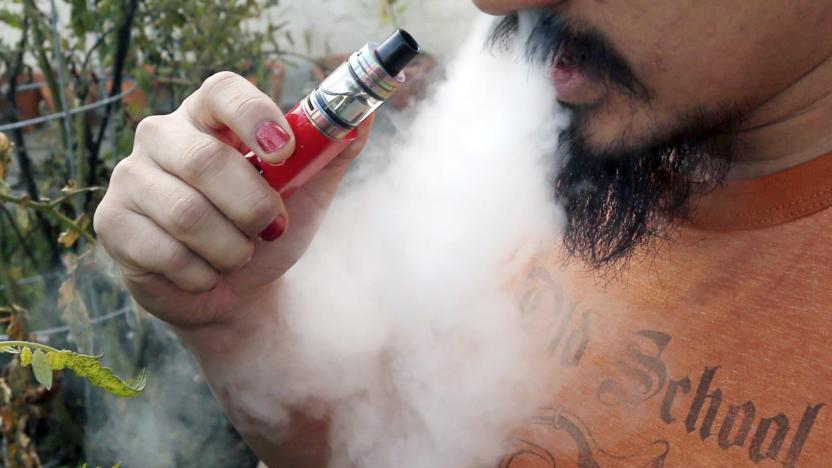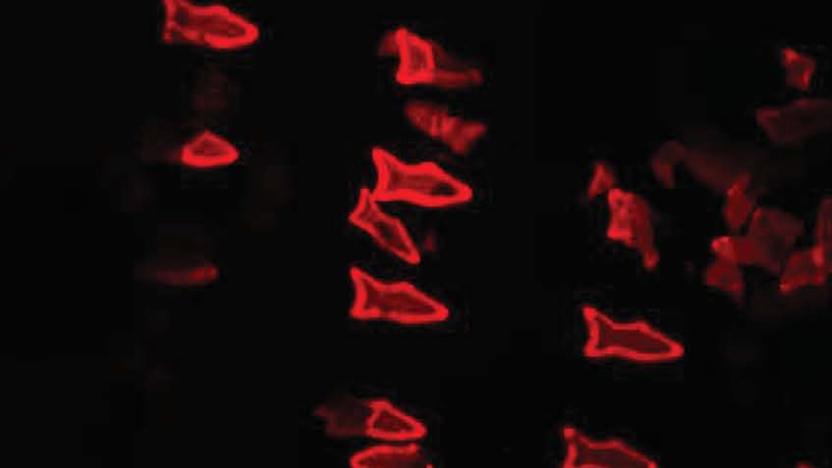toxins
Latest

CDC says a toxic compound may be responsible for vaping illnesses
The Center for Disease Control is edging closer to an explanation for vaping-related lung illnesses. The agency has determined that vitamin E acetate, a compound present in all 29 lung tissue samples obtained from patients, is a "potential toxin of concern." The chemical is used to dilute liquid in e-cigarettes and vaping products that include THC, and is found in some food as well as cosmetic products like skin cream. It doesn't normally cause harm when swallowed or rubbed on your skin, but past research suggests that inhaling might impede lung functions.

Microscopic 'fish' could clean toxins from your bloodstream
Scientists are forever keen to get tiny robots working inside our bodies, despite pop culture warning us against the idea. Researchers from UC San Diego have joined the fray with a new idea: "microfish" robots that could one day "swim" through your bloodstream and cleanse toxins. The team devised a 3D-printing method called "microscale continuous optical printing," that let them create hundreds of fish-shaped bots thinner than a hair in just a few seconds. The printer is capable of creating custom shapes and adding nanoparticles that perform different functions, thanks to millions of micromirrors that project UV light onto photosensitive materials.

iPhone 5 chemical study shows a green Apple, leaves room for improvement
Eventually, that shiny new iPhone 5 will have to meet its untimely end, whether it's in a landfill or (preferably) a recycling company's machinery. When it does, you'll at least be glad to know that Apple has kept the toxin levels down. HealthyStuff and iFixit have dissected the extra skinny smartphone and put it in the same "low concern" category for potential harm that's normally occupied by phones wearing their green credentials on their sleeves. Lest anyone rush to tell Greenpeace about the feat, just remember that there's a difference between proficiency at excising dangerous chemicals and getting rid of them completely: HealthyStuff still found small traces of bromine, chlorine, lead and mercury in the iPhone 5's construction, which could pose risks if the handset is ever broken apart or melted for scrap. Some concern also exists that the x-ray fluorescence spectrometer doesn't reveal the full extent of any toxic materials. Whether or not these remain sore points for you, the new iPhone is at least easier on the eco-friendly conscience than most of its peers.

Inhabitat's Week in Green: the dangers of LED lighting, self-healing nanotech, and spray-on solar power
Each week our friends at Inhabitat recap the week's most interesting green developments and clean tech news for us -- it's the Week in Green. This week Inhabitat shed light on the next generation of solar power as we showcased a spray-on film capable of generating 300% more energy than traditional photovoltaics and a new breed of nanotech cells that can heal themselves like plants. New biofuel projects also broke ground around the world as the US began construction on its first commercial biofuel plant and Canada upgraded a waste plant to be powered by soda and beer. And another farticle, er, article covers a project in Greenpoint, Brooklyn that takes the result of the results of those drinks (methane) and turns it into fuel. We also interviewed energy efficiency expert David Johnston, who shared 5 tips that could cut your electricity bill by up to 50 percent. And on a more sour energy efficiency note, we were appalled to see this new study that found that LEDs, like CFLs, also contain unsafe levels of carcinogenic toxins. The big (or should we say B.I.G) architecture news of the week was the unveiling of Bjarke Ingels Group's sloping residential pyramid for midtown Manhattan. In transportation news, Nissan revealed plans to roll out its Tesla-trouncing ESFLOW electric supercar at the Geneva Auto Show, while Chevrolet announced that the Volt will receive a $5,000 tax rebate in California. We also applauded the US government's $53 billion plan to jump start high speed rail, while republicans rallied against the movement towards more efficient infrastructure. We also showcased several stylish examples of wearable eco tech - a set of bio sensors that improve physical and emotional health, and a pair of GPS-enabled snow goggles that are perfect for shredding through uncharted territory. Finally, we shared 10 green iPad cases that are perfect for protecting your e-reader from blustery winter weather.

UCSD researchers hope to track airborne toxins with sensor-equipped cellphones
If researchers the world over have their way, cellphones will one day be used to detect and track everything from nuclear radiation to pollution to cancer, and it looks like you can now add one more to the group -- some researchers from the University of California, San Diego have developed a tiny sensor that could eventually let cellphones track airborne toxins in real time. To do that, the researchers have proposed a rather novel system that would consist of a tiny silicon sensor that changes color when it interacts with various chemicals, and a equally tiny camera with a macro lens that would actually capture an image of the sensor and display it on the phone's screen. As you might have guessed, however, while the researchers are now showing off the sensor itself, they still have a ways to go on the cellphone part of the equation -- although they have apparently started work on a prototype.

Website rates best and worst cellphones by radiation output levels -- how does yours stack up?
You're surely aware that your cellphone bleeds radiation into your face the whole time you're on the phone with your mom, best friend or lover, right? Yes, it's a fact we try not to think about most of the time, but now there's a tool out there on the internets for the more reality-facing folks among us. The Environmental Working Group's launched a website dedicated to rating cellphones on their radiation output alone. Ranking highly (meaning they put out the lowest levels of radiation) are the Motorola RAZR V8, and AT&T's Samsung Impression. In fact, it seems that Samsung is cranking out the healthiest phones these days! Phones with poor showings includes T-Mobile's myTouch 3G and the Blackberry Curve 8830. So hit the read link and tell us, how does your phone rate?[Via bookofjoe]

Nintendo responds to Greenpeace (again)
Greenpeace has had it in for Nintendo for quite some time now. Despite the Wii being the biggest thing since sliced bread, they've taken up the position of the minority in opposing the system. No, not because of its features or games, but because of Nintendo's supposed lack of caring regarding our environment.Following the latest blow struck by Greenpeace, Nintendo has responded with, well, basically what they did last time. "Nintendo has not been badly rated by Greenpeace," said a Nintendo spokesperson. "Greenpeace chose to conduct a survey and produce a report, which graded companies upon the voluntary submission of information." Nintendo went on further to say that they "fully comply with all the necessary EU Directives on the Restriction of Hazardous Substances aimed at environmental protection and consumer health and safety. Furthermore, in order to ensure our products are safe for use by young children we also take into consideration the standards applicable to toys."[Via CVG]

A PC is like an ogre; it's full of toxic layers
In case we haven't told you this in one of our How-tos already: don't attempt to eat your PC. You'll probably break a few teeth trying it, and a lot of the parts that make up your chunky tower or your sandwich lookalike of a laptop are toxic anyway. PC Magazine outlines some of the common toxic chemicals that make up your PC, and it doesn't make for pleasant reading. For example, did you know that your motherboard's Beryllium base could give you cancer, and your LCD's mercury infused fluorescent bulb, brain damage? OK, so you're not really in any kind of risk unless you go against our wise eating advice earlier, but it certainly makes you think -- specifically, that the innocent box sitting under your desk is trying to kill you. C'mon, these thing are already starting to "randomly" explode; how long until our LCD activates its tilt mechanism and starts dripping mercury into our mouth while we're sleeping, or our laptop sneaks in between two slices of bread? Personally, we're going back to pen, paper, and non-robotic carrier pigeon.Read - Toxics in your PCRead - What's inside your laptop

Chemists craft molecular keypad lock
While the folks behind the AACS could probably use a few pointers about constructing a sufficient lock of their own, a group of scientists at the Weizmann Institute of Science in Rehovat, Israel have crafted a molecule-sized "keypad lock" that "only activates when exposed to the correct password, a sequence of chemicals and light." Organic chemist Abraham Shanzer and his colleagues suggest that their invention could "lead to a new level of safeguards for secret information," but we tend think the infamous hackers of the world would inevitably crack the code. Nevertheless, the molecule -- dubbed FLIP -- houses a core linker that mimics a bacterial compound that binds to iron, and attached to it are two molecules that respectively can glow either blue or green. Using three "buttons," which just so happen to be an acidic molecule, an alkaline compound, and ultraviolet light, the lock can be "opened" if given the right sequence of chemicals and light, and there's a grand total of two noticeable results possible. Interestingly, the researchers have insinuated that their creation could be used to recognize "when certain sequences of chemicals (like harmful toxins) are released in the body," but we haven't heard a 10-4 from the US Army just yet.[Via Yahoo, thanks, Antonio H.]




